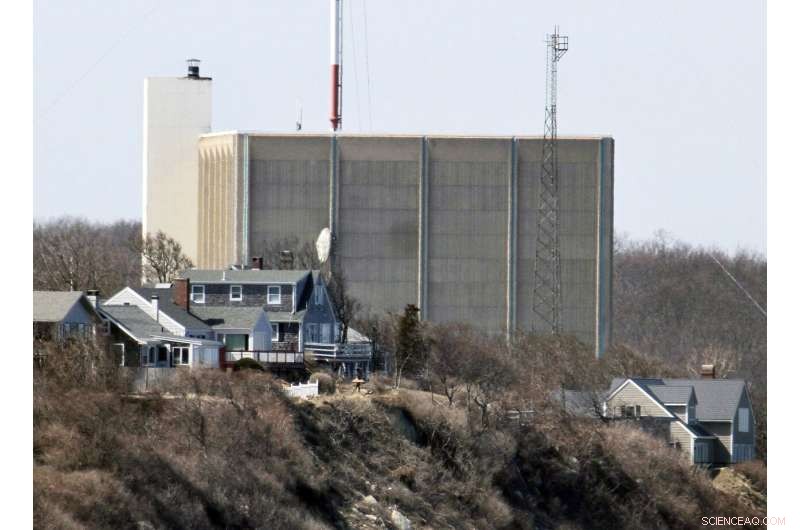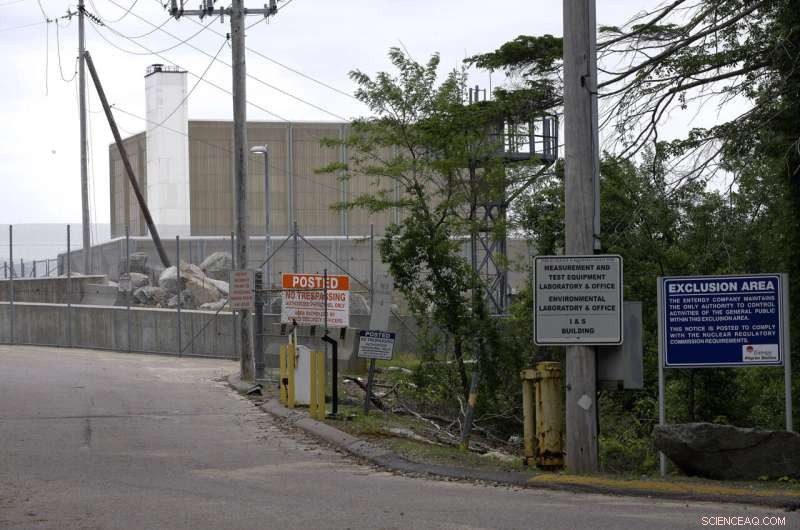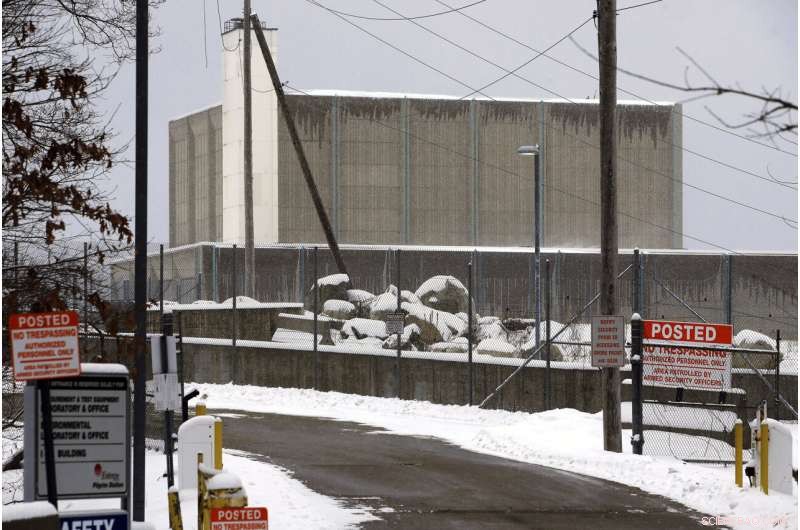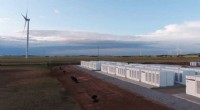EXPLAINER:Hvad skal man gøre med lukkede atomanlægs spildevand?

En del af Pilgrim Nuclear Power Station er synlig bag huse langs kysten af Cape Cod Bay, i Plymouth, Massachusetts, 30. marts 2011. Pilgrim, som lukkede i 2019, var en kogende vandreaktor. Vand cirkulerede konstant gennem reaktorbeholderen og nukleart brændsel og omdannede det til damp for at dreje turbinen. Vandet blev afkølet og recirkuleret og opsamlede radioaktiv forurening. Kredit:AP Photo/Steven Senne, Fil
En million gallons radioaktivt vand er inde i et tidligere atomkraftværk langs Cape Cod Bay, og det skal væk.
Men hvor er det irriterende spørgsmål, og vil staten gribe ind, efterhånden som virksomheden, der afmonterer anlægget, beslutter?
Holtec International overvejer at rense vandet og udlede det i bugten, hvilket trækker hård modstand fra lokale beboere, skaldefiskere og politikere. Holtec overvejer også at fordampe det forurenede vand eller transportere det til et anlæg i en anden stat.
Kampen i Massachusetts afspejler en aktuel, ophedet debat i Japan om en plan om at frigive mere end 1 million tons renset radioaktivt spildevand i havet fra det ødelagte Fukushima-atomkraftværk i foråret 2023. En massiv tsunami i 2011 styrtede ind i anlægget. Tre reaktorer smeltede om.
Pilgrim Nuclear Power Station i Plymouth, Massachusetts, lukkede i 2019 efter næsten et halvt århundrede at levere elektricitet til regionen. Den amerikanske repræsentant William Keating, en demokrat, hvis distrikt omfatter Cape, skrev til Holtec med andre toplovgivere i Massachusetts i januar for at modsætte sig frigivelse af vand i Cape Cod Bay. Han bad U.S. Nuclear Regulatory Commission om at undersøge dens regler.
Keating sagde i slutningen af marts, at Holtecs håndtering af det radioaktive vand kunne skabe præcedens, fordi den amerikanske nedlukningsindustri er i sin vorden. De fleste amerikanske atomkraftværker blev bygget mellem 1970 og 1990.
"Hvis de er lyttende, følsomme og arbejder med disse samfund, er det vigtigt," sagde han. "Det er budskabet til fremtidige nedlukningssteder."
Holtec har erhvervet lukkede atomkraftværker over hele landet som en del af sin demonteringsvirksomhed, herunder den tidligere Oyster Creek Generating Station i New Jersey og Indian Point Energy Center i New York. Det overtager ejerskabet af Palisades Nuclear Plant på Lake Michigan, som lukker i år.
Pilgrim var en kogende vandreaktor. Vand cirkulerede konstant gennem reaktorbeholderen og nukleart brændsel og omdannede det til damp for at dreje turbinen. Vandet blev afkølet og recirkuleret og opsamlede radioaktiv forurening.
Cape Cod er et turisthotspot. At have radioaktivt vand i bugten, selv lave niveauer, er ikke fantastisk til markedsføring, sagde den demokratiske statsrepræsentant Josh Cutler, der repræsenterer et distrikt der. Cutler arbejder på at vedtage lovgivning, der forbyder udledning af radioaktivt materiale til kyst- eller indre farvande.
Holtec sagde, at Pilgrim allerede udledte vand i bugten i 50 år, mens anlægget var i drift, og miljøundersøgelser, udført af anlægsoperatørerne og nu Holtec, har vist ringe eller ingen miljøpåvirkning. Radiologiske miljørapporter deles med NRC årligt.
"Vi arbejder på at levere videnskabelige data, uddanne offentligheden om virkeligheden af stråling i hverdagen og arbejder på at få eksperter til at forklare den sande videnskab versus den følelsesmæssige frygt for det ukendte," skrev talsmand Patrick O'Brien i en e-mail i marts. .

Warning signs are posted near a gate to the Pilgrim Nuclear Power Station, in Plymouth, Mass., Tuesday, May 28, 2019. Pilgrim, which closed in 2019, was a boiling water reactor. Water constantly circulated through the reactor vessel and nuclear fuel, converting it to steam to spin the turbine. The water was cooled and recirculated, picking up radioactive contamination. Credit:AP Photo/Steven Senne, File
WHAT ARE HOLTEC'S OPTIONS?
Holtec could treat the water and discharge it in batches over multiple years, likely the least expensive option. Or, it could evaporate the water on site, as it says it has done with about 680,000 gallons (2,600 kiloliters) over the past two years.
Evaporating the water would be more challenging to do now because the spent nuclear fuel is in storage, and couldn't be used as a heat source. Holtec would have to use a different—likely more expensive—method that would release gas.
Or, Holtec could truck the water to an out-of-state facility, where it could be mixed with clay and buried or placed in an evaporation pond, or released into local waterways. That's what Keating wants.
Vermont Yankee Nuclear Power Station, another boiling water reactor, was shut down in Vernon, Vermont, in 2014. It's sending wastewater to disposal specialists in Texas and other states. Entergy operated and sold both Vermont Yankee and Pilgrim. NorthStar, a separate and competing corporation in the decommissioning business, is dismantling Vermont Yankee.
Nuclear plants occasionally need to dispose of water with low levels of radioactivity when they're operating, so a process to release it in batches into local waterways was developed early in the nuclear industry.
In recent years at Pilgrim, the two largest releases were in 2011, with 29 releases totaling about 325,000 gallons (1,500 kiloliters), and 2013, with 21 releases totaling about 310,000 gallons.
The water from those releases was well below the federal limits for the amount of radionuclides in millirems a person would be exposed to in a year if they ate local seafood or swam in nearby waters, according to the NRC.
NRC spokesperson for the Northeast Neil Sheehan said the limits are set very conservatively and are believed to be protective of the public and environment. He said it's important to consider the role of dilution—once the discharges mix with vast quantities of water any radioactivity is typically not detectable.
WHY ARE PEOPLE WORRIED?
In Duxbury, Kingston and Plymouth Bays, there are 50 oyster farms—the largest concentration in the state, worth $5.1 million last year, according to the Massachusetts Seafood Collaborative. The collaborative said dumping the water would devastate the industry, and the local economy along with it.
Diane Turco, a Harwich resident and longtime Pilgrim watchdog, questions if the water is heavily contaminated, especially from the pool that covered the stored, spent fuel for cooling and shielded workers from radiation.

A no trespassing sign is posted near the entrance to the Pilgrim Nuclear Power Station, at rear, Thursday, Feb. 28, 2019, in Plymouth, Mass. One million gallons of radioactive water is contained inside the former nuclear power plant along Cape Cod Bay. The plant's owner, Holtec International, is considering treating the water and discharging it into the bay. Local residents, shell fishermen and politicians disapprove of the plan. Credit:AP Photo/Steven Senne, File
"Isn't this a crazy idea for Holtec to use our bay as their dump? No way," she said.
Others didn't know Pilgrim's water went into the bay in previous years and they don't want it to happen again.
"We can't change that, but we can change what's happening in the future," said Cutler, the state lawmaker. "It's the first time it has ever been decommissioned, so to compare this to the past is a convenient excuse. 'Well, we did it in the past,' that sounds like my kid."
Towns on the Cape are trying to prohibit the dispersal of radioactive materials in their waters. Tribal leaders, fishermen, lobstermen and real estate agents have publicly stated their opposition as well.
Sheehan, the NRC spokesperson, said the water is not different or distinct, compared to water released during the plant's operations. Holtec would have to handle it the same way, by filtering it, putting it into a tank, analyzing the radio isotopes and calculating the environmental impacts if it was released in batches, he added.
WHO GETS THE FINAL SAY?
Holtec wouldn't need a separate approval from the NRC to discharge the water into the bay. However, Holtec would need permission from the U.S. Environmental Protection Agency if the water contained pollutants regulated by the Clean Water Act, such as dissolved metals.
If the water contained only radioactive materials regulated by the NRC, Holtec wouldn't need to ask the EPA for a permit modification, according to the EPA's water division for New England. Holtec has never given the EPA a pollutant characterization of the water associated with decommissioning, the division's director said.
Mary Lampert, of Duxbury, is on a panel created by the state to look at issues related to the Pilgrim's decommissioning. She believes the state could use its existing laws and regulations to stop the dumping and plans to press the Massachusetts attorney general to file a preliminary injunction to do so.
The attorney general's office said it's monitoring the issue and would take any Clean Water Act violations seriously.
Holtec said this week it's examining the water for possible pollutants but the lab results won't be available for awhile.
The company expects to decide what to do with the water later this year. Discharge, evaporation and some limited transportation will likely all be part of the solution, Holtec added.
 Varme artikler
Varme artikler
-
 En dyb læringsteknik til kontekstbevidst følelsesgenkendelseIntuition af CAER-Net til uprimede videoer, som i (a) konventionelle metoder, der kun udnytter ansigtsområderne, som i (b), ofte ikke genkender følelser. I modsætning til disse metoder, CAER-Net fokus
En dyb læringsteknik til kontekstbevidst følelsesgenkendelseIntuition af CAER-Net til uprimede videoer, som i (a) konventionelle metoder, der kun udnytter ansigtsområderne, som i (b), ofte ikke genkender følelser. I modsætning til disse metoder, CAER-Net fokus -
 Der er mere end nok solenergi til at opfylde energibehovet - problemet er at lagre detTeslas massive 100 megawatt batterifacilitet i South Australia gemmer vedvarende energi fra vindmøller-men at flytte hele verden til kilder som vind og solenergi vil kræve nye måder at lagre energien
Der er mere end nok solenergi til at opfylde energibehovet - problemet er at lagre detTeslas massive 100 megawatt batterifacilitet i South Australia gemmer vedvarende energi fra vindmøller-men at flytte hele verden til kilder som vind og solenergi vil kræve nye måder at lagre energien -
 Politiets cam maker nixes udrulning af ansigtsgenkendelsePolitiets udstyrsproducent Axon sagde, at ansigtsgenkendelse ikke vil blive brugt på dets kropskameraer, efter at en etisk gennemgang fandt, at teknologien endnu ikke var pålidelig nok Politiets u
Politiets cam maker nixes udrulning af ansigtsgenkendelsePolitiets udstyrsproducent Axon sagde, at ansigtsgenkendelse ikke vil blive brugt på dets kropskameraer, efter at en etisk gennemgang fandt, at teknologien endnu ikke var pålidelig nok Politiets u -
 Lavprisnavigationssystem til ubemandede luftsystemerKredit:CC0 Public Domain Et EU-finansieret initiativ har udviklet et billigt positionerings- og navigationssystem til ubemandede luftsystemer (UAS). Brug af flere antenner, enheden er baseret på h
Lavprisnavigationssystem til ubemandede luftsystemerKredit:CC0 Public Domain Et EU-finansieret initiativ har udviklet et billigt positionerings- og navigationssystem til ubemandede luftsystemer (UAS). Brug af flere antenner, enheden er baseret på h
- Forskere observerer ultrahurtige processer af enkelte molekyler for første gang
- Colombia kan miste 60 % af jorden, der er egnet til kunstvandede ris på grund af klimaændringer
- Undersøgelse:Oprindelige folk ejer eller administrerer mindst en fjerdedel af verdens jordoverflade
- Sådan skrives den afbalancerede kemiske reaktion til rustning af jern
- At stole på karma:Forskning forklarer, hvorfor forargelse normalt ikke resulterer i revolution
- Sådan beregnes ton køling til et køletårn


